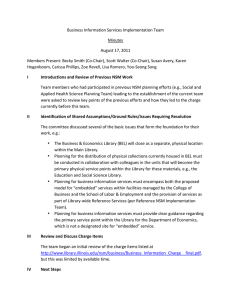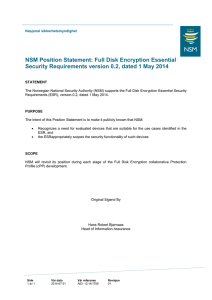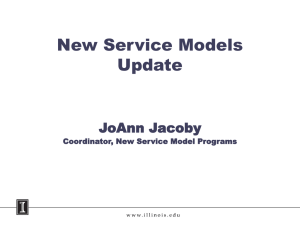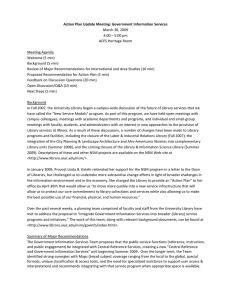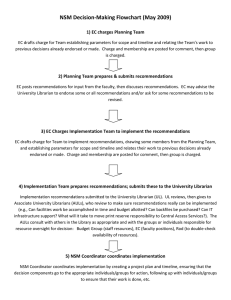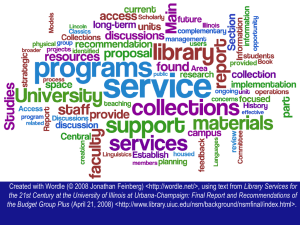New Service Models 2008-2009 Report Introduction
advertisement
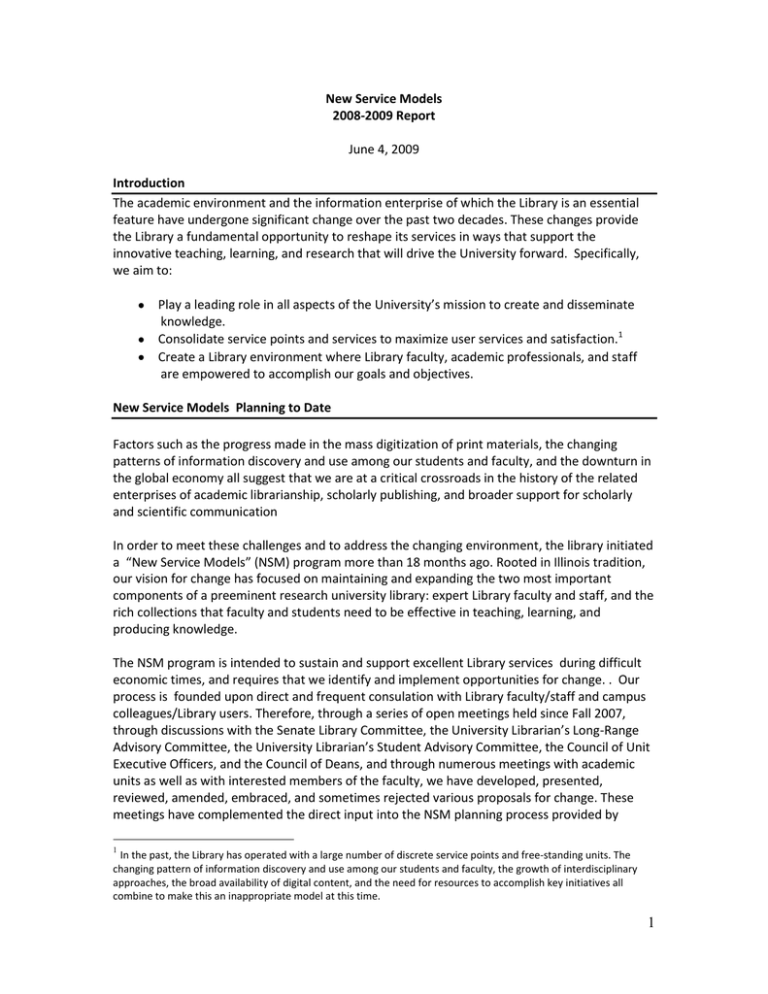
New Service Models 2008-2009 Report June 4, 2009 Introduction The academic environment and the information enterprise of which the Library is an essential feature have undergone significant change over the past two decades. These changes provide the Library a fundamental opportunity to reshape its services in ways that support the innovative teaching, learning, and research that will drive the University forward. Specifically, we aim to: Play a leading role in all aspects of the University’s mission to create and disseminate knowledge. Consolidate service points and services to maximize user services and satisfaction.1 Create a Library environment where Library faculty, academic professionals, and staff are empowered to accomplish our goals and objectives. New Service Models Planning to Date Factors such as the progress made in the mass digitization of print materials, the changing patterns of information discovery and use among our students and faculty, and the downturn in the global economy all suggest that we are at a critical crossroads in the history of the related enterprises of academic librarianship, scholarly publishing, and broader support for scholarly and scientific communication In order to meet these challenges and to address the changing environment, the library initiated a “New Service Models” (NSM) program more than 18 months ago. Rooted in Illinois tradition, our vision for change has focused on maintaining and expanding the two most important components of a preeminent research university library: expert Library faculty and staff, and the rich collections that faculty and students need to be effective in teaching, learning, and producing knowledge. The NSM program is intended to sustain and support excellent Library services during difficult economic times, and requires that we identify and implement opportunities for change. . Our process is founded upon direct and frequent consulation with Library faculty/staff and campus colleagues/Library users. Therefore, through a series of open meetings held since Fall 2007, through discussions with the Senate Library Committee, the University Librarian’s Long-Range Advisory Committee, the University Librarian’s Student Advisory Committee, the Council of Unit Executive Officers, and the Council of Deans, and through numerous meetings with academic units as well as with interested members of the faculty, we have developed, presented, reviewed, amended, embraced, and sometimes rejected various proposals for change. These meetings have complemented the direct input into the NSM planning process provided by 1 In the past, the Library has operated with a large number of discrete service points and free-standing units. The changing pattern of information discovery and use among our students and faculty, the growth of interdisciplinary approaches, the broad availability of digital content, and the need for resources to accomplish key initiatives all combine to make this an inappropriate model at this time. 1 members of the campus community who have served on one of the “NSM planning teams” charged since Spring 2008 by the Library Executive Committee. Information on several of these meetings and on the NSM planning teams charged to date is available at <http://www.library.illinois.edu/nsm/> The NSM program has been coordinated since Summer 2008 by JoAnn Jacoby, a tenured member of the Library faculty. Our NSM planning process has benefited from the advice, review, and endorsement by the Library’s Executive Committee and by the comments, feedback and input provided by myriad other Library employees and campus faculty. The current report reviews the changes made to the organization of Library services as part of the NSM program during its first two years, and provides an update on current NSM program plans and initiatives. Key Planning Assumptions While continually informed by the interests and concerns of our user communities, a basic assumption underlying our planning and implementation process is that we cannot maintain the status quo. Substantive short-term changes are a pre-requisite for maintaining long-term excellence. Recognizing the same changes and challenges, peer research libraries, including those at Berkeley, Harvard, Cornell, and Columbia, have launched similar efforts. The changes implemented as part of the NSM program are rooted in the Library’s ongoing commitment to its core values of service to teaching, scholarship, and preservation of our cultural heritage, and to its tradition of excellence in services and collections. The academic library of the twenty-first century will be distinguished by the scope and quality of its services. To meet the numerous challenges of designing a library for the next generation, we must embrace changes in our organization and methods of conducting work. We must make decisions that are consistent with our core values of service to teaching, service to scholarship, and service to our cultural heritage. The Library’s future must be guided by these service imperatives.2 The changes implemented as part of the NSM program are also rooted in the core commitments to Library service at Illinois outlined in the Budget Plus Group’s “Final Report” We commit ourselves to supporting faculty, staff, and students in their core teaching, learning, research and service activities by: assigning subject specialists documented responsibilities for providing library services, collections, information resources, and information products; acquiring and providing access to rich collections of published scholarship, primarysource research materials, and related resources; fostering regular communication and collaboration between faculty, students, and library professionals through the design of service programs, physical spaces, and technology-enhanced academic environments; and 2 Our “Statement on Library Services,” in which our guiding values are elaborated, is available at <http://www.library.uiuc.edu/nsm/background/service_imperatives.html> 2 improving library facilities in order to provide appropriate physical environments, both for our users and for the long-term preservation of the cultural and scholarly records for which we serve as stewards. The University Library re-affirms its core values and core commitments as the starting point for addressing the significant (and growing) challenges that it faces in maintaining its place as a world-class research library, and re-affirms that its vision for sustaining these values and commitments to service are founded on an overarching commitment to collaboration as a member of the academic community. New Service Models 2007-2008 Labor and Industrial Relations Library Closed (September 2007) Labor and Employment Relations Digital Library Launched “Interim Report” of the NSM Planning Team (“Budget Group Plus”) (November 2007) Town Hall Meetings on the New Service Models (Fall 2007 – Spring 2008) “Final Report” of the NSM Planning Team (April 2008) City Planning and Landscape Architecture Library Closed (May 2008) CPLA Reference and Resource Center Opened in ACES Library The major achievement of the Library’s initial NSM planning team was the development of the agenda for change articulated in the “Final Report” <http://www.library.illinois.edu/nsm/background/nsmfinal/> – one designed to encourage discussion, review, and revision by members of the Library faculty and staff and by members of the campus community. Even while this broader view of the NSM program was being developed, a number of discrete decisions were agreed upon and implemented. Chief among these were the decisions to close the Labor and Industrial Relations Library and to integrate the City Planning and Landscape Library with the Funk Family College of ACES Library. The Labor and Industrial Relations (LIR) Library was closed in September 2007 following discussions with the Dean of the School of Labor and Industrial Relations [now the School of Labor and Employment Relations (SLER)] regarding the School’s need for space and the limited use of the Library’s physical space, as measured by standard metrics such as gate count, user count, and use of reference and information services. In collaboration with SLER faculty and administration, the Library subject specialist for Labor and Employment Relations designed a new service model that focused on: 1) the re-location of the subject specialist to an office within the School (referred to as an “embedded library service model”); and 2) the development of a comprehensive Web-based information resource focused on information sources and services relevant to the study of Labor and Employment Relations (“Web portal”). As part of our decision to close the LIR Library, we made a commitment to address long-term backlogs in processing materials housed in that unit and to making them more accessible to scholars and students in the field, including a unique collection of vertical files and manuscripts now under the curatorial control of the University Archives. The LER subject specialist now maintains an office in the School, as well as a presence in the Business and Economics Library. The Labor & Employment Relations Digital Library is available at <http://www.library.uiuc.edu/ler/>. The City Planning and Landscape Architecture (CPLA) Library was closed in May 2008 following discussions with the Department of Urban and Regional Planning, the Department of Landscape Architecture, and the College of Fine and Applied Arts Library Committee. Located in Mumford 3 Hall, the CPLA Library was among our least-used departmental libraries. Following initial discussions with academic units in the College of Fine and Applied Arts during Summer and Fall 2007, we decided to integrate the CPLA services and collections with those of the ACES Library. A planning team including Library faculty and staff, FAA faculty, and administrators from Fine and Applied Arts and ACES was charged in December 2007, and the integration of the two units was completed during Summer 2008. Owing to budgetary pressures, the Provost did not approve our Fall 2008 request to fill the vacant CPLA subject specialist position, and those responsibilities were assigned to a Library faculty member housed in the ACES Library. The ACES Library now includes a “CPLA Reference and Resource Center” designed to highlight the specialized information resources and services of relevance to scholars and students in the fields of Urban and Regional Planning and Landscape Architecture. As part of the decision to close the CPLA Library, we made a commitment to review the processing and curatorial needs of materials housed in that unit, including a collection of vertical files and a collection of rare books. An opportunity to bring the records of the East St. Louis Action Research Project (ESLARP), currently housed in the College of Fine and Applied Arts, under the curatorial control of the University Archives was also identified, but has been deferred pending the identification of resources needed to process this unique collection. The final report of the CPLA-ACES Planning Team is available at <http://www.library.illinois.edu/nsm/cpla/>. New Service Models Summer 2008 New Service Models Coordinator Named (Summer 2008) NSM Web Site Launched Afro-Americana Library Unit Closed (Summer 2008) African-American Research Center Opened in History, Philosophy, and Newspaper Library Information Processing and Management (IPM) Unit Relocated from Undergraduate Library to Central Technical Services One of the underlying assumptions of the New Service Models program is that opportunities will arise outside those identified in the process and that such opportunities must be explored to the degree that they complement the broader directions for change supported by the NSM program. The emergent design of the NSM program provided us with the opportunity to integrate the Afro-Americana Library Unit with the History, Philosophy, and Newspaper Library during Summer 2008. The proposal to integrate these units came from their unit Heads, Following consultation with faculty members in the Department of African American Studies, implementing this proposal allowed us to bring together complementary service programs in a space open for longer hours each day than the Afro-Americana Library Unit had been; it also allows the African-American Studies subject specialist to be housed in HPNL, which now includes an “African-American Research Center” designed to highlight Library collections relevant to African-American Studies. 4 A similar change was made when the Information Processing and Management (IPM) unit responsible for processing electronic reserve requests across the University Library relocated from the Undergraduate Library to the Content Access Management (CAM) unit of Central Technical Services. By bringing together Library faculty and staff with similar responsibilities for processing Library materials, designing and applying metadata schemes, and enhancing access to print and digital content, implementing this proposal has allowed us to direct additional expert resources to addressing long-term backlogs in the processing of gift materials and other resources now more easily accessible to our users. New Service Models 2008-2009 Scholarly Commons Plan Accepted and Endorsed by Executive Committee (Fall 2008) Stacks Services Plan Accepted and Endorsed by Executive Committee (Fall 2008) Technical Services Coordination and Consolidation Plan Accepted and Endorsed by Executive Committee (Fall 2008) “Action Plan” Meetings (Spring 2009) International and Area Studies Library Proposed (Spring 2009) Integration of Government Documents Library and Central Reference Services Proposed (Spring 2009) Closing of Physics and Astronomy Library Proposed (Spring 2009) Library and Information Science Library Closed (May 2009) The second year of the NSM program began with the Library moving forward on a number of ideas presented in the “Final Report,” including those related to coordinating our technical services programs, enhancing user services in the Main Stacks, and articulating a vision for the Scholarly Commons service program. Also during this time, the Library continued discussing a number of discrete proposals, including those to integrate the Library and Information Science Library with the Communications Library, to integrate the Government Documents Library with Central Reference Services, and to integrate a number of Library units into an “International and Area Studies Library.” Planning accelerated from January 2009 following the receipt of a letter from Provost Katehi asking for a more aggressive approach to achieving substantive change in the organization of Library services. Several of the NSM activities described below were able to be considerably moved forward owing to the impetus provided by the Provost’s letter. The Scholarly Commons has been the subject of discussion in the Library since it was identified as a goal in the Library’s Strategic Plan of 2006 <http://www.library.illinois.edu/administration/services/planning/strategic_planning/strategic_ plan_2006.pdf>. Building on the work of two previous committees, a planning team composed of Library faculty, as well as faculty and staff drawn from campus partners in existing scholar service programs (e.g., Illinois Informatics Institute, CITES, Graduate College), prepared a report that included a vision for the Scholarly Commons service program and a set of short-term and long-term recommendations to coordinate scholar service programs across the Library and the campus. As of May 2009, the Executive Committee has approved an internal search for a “Scholarly Commons Coordinator” to lead the development of this program, and an initial space for the Scholarly Commons has been identified on the 3rd floor of the Main Library. Establishing the Scholarly Commons in this space will complement the re-location of the Illinois Informatics Institute and the Data Services Unit of Applied Technologies for Learning in the Arts and 5 Sciences (ATLAS) to the Main Library in August 2009. The final report of the Scholarly Commons Planning Team, as well as related material, is available at <http://www.library.illinois.edu/nsm/scholcom/>. Plans to implement the Scholarly Commons service program were the subject of a May 2009 story in Inside Illinois <http://news.illinois.edu/ii/09/0507/scholarlycommons.html>. Fall 2008 also saw the submission of two other NSM planning reports with Library-wide impact: Stacks Services Report <http://www.library.illinois.edu/nsm/stacks/Stacks_Services_Planning_Team_Report_x Finalx.pdf>; and Technical Services Coordination and Consolidation Report <http://www.library.illinois.edu/nsm/techserv/Technical_Services_Report_With_Appen dix_B.pdf>. While both reports identify long-term goals for improving Library services and access to Library materials, each includes short-term goals that have been implemented already, and that will shape decisions regarding the allocation of resources in the coming year. Among the major decisions were: to invest substantial unrestricted gift resources to address long-term backlogs in processing serials selected by subject specialists for transfer to Oak Street and allow for progress to be made in shifting collections held in the Main Stacks; to reconfigure the Central Circulation Desk and the Delivery Room to enhance public service, streamline user entry into the Main Stacks, and allow for the implementation of Central (print) Reserves in the Main Library; and to integrate the technical services operations housed in the Slavic and East European Library, the Latin American and Caribbean Studies Library, and the Government Documents Library with Central Technical Services units. As of May 2009, considerable progress has been made in each of these areas. Support for the acquisitions and processing of Latin American materials has been enhanced through coordinating efforts between central Acquisitions staff and staff in the Latin American and Caribbean Studies Library; the LACS staff member with responsibility for technical services will move into the Acquisitions unit in June 2009. Faculty and staff with responsibility for technical services operations in the Slavic and East European Library have likewise begun to be integrated with Central Technical Services, a change that will enhance support for acquiring and processing these materials while also allowing us to release one Library faculty member from technical services responsibilities so that she might contribute to pressing needs in another Library unit. Planning for the integration of Government Documents technical services continued through Spring 2009, and faculty and staff with those responsibilities are scheduled to be integrated into Central Technical Services units by July 2009. Finally, the “Oak Street Serials” project began in May 2009, and the final plans for a reconfigured Central Circulation Desk will be completed prior to the Fall 2009 semester. More information on the Stacks Services program is available at 6 <http://www.library.illinois.edu/nsm/stacks/>. More information on the Technical Services program is available at <http://www.library.illinois.edu/nsm/techserv/>. Finally, it should be noted that these programs are being pursued in conjunction with another NSM program in support of the development of a “Retrospective Reference Collection” within the Main Stacks. Information on the Retrospective Reference Collection program is available at <http://www.library.illinois.edu/nsm/retroref/>. While not identified as part of the NSM program, our attention to providing access to materials long hidden from our users owing to delays in processing has not been limited to the activities noted above. In 2008-09 we allocated funds from state and gift sources to support cataloging cartographic materials, children’s literature materials, Asian language materials, and materials housed in our Rare Book and Manuscript Library (we also expect to receive a grant from the State Library to support this latter work). In addition, funds were made available from our central pool of NSM program resources to support the processing of collections housed in the Physics and Astronomy Library, the Library and Information Science Library, and the Illinois History and Lincoln Collections. Similar work will continue in future years. Just as our efforts at improving access to Library materials and to addressing the recommendations made in the Stacks Services and Technical Services reports took place throughout the year, so did our efforts to address the recommendation made in the “Final Report” to integrate the Library and Information Science Library with the Communications Library to create a “Media and Information Studies Library.” The Communications-LIS discussions demonstrate another of the assumptions underlying the NSM program: ideas for change proposed at early stages of the planning process are subject to revision following further study. The LIS Library was among our least-used departmental libraries, as measured by standard metrics, and had also been affected by changes in the research and teaching program of its liaison academic program in the Graduate School of Library and Information Science (GSLIS). The maturation of the GSLIS distance learning option (LEEP), the penetration of digital content, and the distribution of collections and services of interest to scholars and students in the field across a number of other Library units, all suggested that a new approach to serving this field was needed. A planning team composed of Library faculty and staff, as well as faculty from GSLIS and the College of Media, was charged in Fall 2008 to address the proposal to create an integrated “Media and Information Studies Library.” Following a process of consultation with faculty and students in both programs, as well as faculty and staff in the University Library (a key constituency for the LIS Library), the original idea was rejected, and an approach modeled on the one developed for Labor and Employment Relations was pursued. As part of the decision to close the LIS Library in May 2009, we made a commitment to address long-term backlogs in processing materials housed in that unit so as to make them more accessible to scholars and students in the field, including a unique collection of Library annual reports; we additionally committed to bring like collections together across the Library, e.g., the integrating children’s literature and school library materials with complementary collections of the Education and Social Science Library. As in the LER model, the LIS subject specialist will maintain an office space in the GSLIS building and will develop a robust virtual Library service program that will allow her to address the full scope of scholarship in this field in a way that was impossible in the LIS Library space. The Library and Information Science Digital Library is currently under development and will be ready in time for the Fall 2009 semester. Materials related to the development of this New Service Model are available at <http://www.library.uiuc.edu/nsm/comm_lis>. 7 Each of the NSM program activities reported on above were rooted in plans presented as part of the “Final Report” in April 2008. Also found in the “Final Report” were proposals related to integrating several Library units into an “International and Area Studies Library,” and to integrating Government Information Services into broader Library service programs. While the issue of integrating technical services in both of these areas was addressed as part of the Technical Services Coordination and Consolidation report, Spring 2009 saw considerable progress made on the broader issues inherent in these proposals. The idea of integrating our existing Area Studies units has been discussed for several years, and the first year of the NSM program included intensive discussions of the “International and Area Studies” (IAS) proposal, both at open meetings with the campus community, and in meetings with faculty from the Center for Latin American and Caribbean Studies and the Russian, East European, and Eurasian Center. Building on these discussions, the Executive Committee charged a planning team composed of Library faculty and staff, as well as faculty from two of the liaison National Resource Centers. In discussing the idea of the IAS Library, committee members consulted with William Brustein, Associate Provost for International Affairs, Ruth Watkins, Dean of the College of Liberal Arts & Sciences, Ann Mester, Associate Dean of the College of Liberal Arts & Sciences for Undergraduate Education and Curriculum and Area Studies Centers, the Directors of the liaison National Resource Centers, and other Library faculty. Considerable discussion of this proposal also took place as part of the “Action Plan” meetings in Spring 2009. While there are several implementation questions still to be explored as part of the NSM program in 2009-10, the overarching recommendation of the committee to pursue the establishment of an IAS Library that will support enhanced coordination and collaboration across the Library in the design and delivery of Library services in these areas, and to support our ongoing commitment to the developing our rich collection of international materials and to providing access to subject specialists who support the use of those materials by faculty, staff, students, and visiting scholars, was accepted and endorsed by the Executive Committee. In light of that endorsement, we have begun to takes steps that will bring us closer to our ultimate goal of establishing the new unit in the coming years, including the decision to close the independent service points currently associated with the Africana Library Unit and the Latin American and Caribbean Studies Library in June 2009, and to re-locate those services temporarily to the Modern Languages & Linguistics Library while plans progress for establishing the IAS Library in the near future. The report of the International and Area Studies planning team, and related material, is available at <http://www.library.illinois.edu/nsm/intstudies/>. Integrating government information services with broader public and technical services is a change in service model that has been pursued in the majority of American research libraries; it recognizes the significance of government information for research, teaching, and learning across the curriculum, the impact of increasing digital access to government information resources, and the impact of ongoing discussions within the library community regarding the future of the existing system of depository agreements. Building on the earlier decision to integrate technical services for government documents with Central Technical Services units, the Executive Committee charged a planning team made up of Library faculty and staff to consider how public services related to government information might be integrated into the broader service program provided by Central Reference Services. This planning team recommended the creation a new unit (Central Reference and Government Information Services) and the recasting of position of Head of the Government Documents Library as Coordinator of 8 Government Information with responsibilities to ensure compliance with federal depository requirements and promote the use of government information library wide. These proposals were discussed as part of the “Action Plan” meetings in Spring 2009 and the recommendation to integrate these service programs as of July 2009 was endorsed by the Executive Committee. Focus group discussions with faculty and researchers have further informed development of services supporting the use of government information. One final proposal, not included in the “Final Report” of 2008, but raised as part of the development of the “Action Plan,” was to close the Physics and Astronomy Library. This matter has been discussed for years, and significant changes to the make-up of the on-site Library collection, the service spaces, and, most importantly, the virtual services had already been made in close consultation with the Department of Physics and Astronomy. Based on this progress toward a new service model, the Executive Committee has endorsed the decision to close the Physics and Astronomy Library in June 2009. Materials will be transferred to Grainger or to the Oak Street Library Facility during Summer 2009, and the Library space in Loomis Laboratory will be vacated by the University Library no later than September, 2009. New Service Models Summer 2009 Africana Library Unit and Latin American and Caribbean Studies Library Physical Spaces Closed (June 2009) Africana and Latin American and Caribbean Studies Library Services Relocated Temporarily to Modern Languages and Linguistics Library Physics and Astronomy Library Closed (June 2009) Physics and Astronomy Library Services Relocated to Grainger Engineering Library Government Documents Library Closed (July 2009) Central Reference and Government Information Services Unit Established Illinois History and Lincoln Collections Relocated to 3rd Floor of Main Library Our major NSM program activities for Summer 2009 grow out of the plans made during the previous academic year, including the decisions to relocate the Africana Library Unit and Latin American and Caribbean Studies Library temporarily, and close the Physics & Astronomy Library, and Government Documents Library. While work progresses on implementing these changes and establishing the new service points for these services in the Modern Languages and Linguistics Library and the Grainger Engineering Library, we will also take the opportunity provided by the temporary relocation of the Latin American and Caribbean Studies Library to implement the proposal found in the “Final Report” to relocate the Illinois History and Lincoln Collection. While work had been ongoing throughout Spring 2009 to improve the conditions under which service was provided for IHLC materials housed in the Stacks, the opportunity to completely relocate the IHLC faculty, staff, and services to a service point in close proximity to those materials (and to related materials housed in the Rare Book and Manuscript Library), will result in a significant enhancement to IHLC services. In addition, the Library has allocated funds from NEH endowment earnings for a significant project focused on enhancing access to IHLC collections by addressing long-term backlogs in manuscript processing. Each of the NSM programs noted above for implementation during Summer 2009 was discussed as part of the New Service Model meetings held across campus during Spring 2008 or as part of 9 the “Action Plan” meetings held during Spring 2009. At the conclusion of the “Action Plan” discussions in May 2009, it was clear that several other changes proposed as part of those discussions would benefit from further study. During Summer 2009, and in consultation with the Executive Committee and other campus stakeholders, we will establish planning teams charged to address ideas raised as part of the “Action Plan” process, including the next steps for the International and Area Studies Library, the proposals to close the Applied Health Sciences Library, the Geology Library, and the Biology Library, and the development of new Library units in the Main Library focused on research, teaching, and learning through literature and literary analysis and the Social Sciences. Finally, while not NSM programs per se, Summer 2009 will see the relocation of the Illinois Informatics Institute and the ATLAS data services unit to the 3rd floor of the Main Library. By integrating such allied academic programs within the Main Library facility, we hope to promote the coordinated approach to providing scholar services that is central to our vision of the Scholarly Commons. New Service Models 2009-10 Planning Teams Will Be Charged for: Applied Health Sciences Biology and Life Sciences Geology/Earth, Society, and the Environment Literatures, Languages, and Textual Analysis Social and Behavioral Sciences Implementation Team Will Be Charged for: International and Area Studies The third year of the NSM program will begin by building on the discussions initiated as part of the “Action Plan” meetings of Spring 2009. Several of the actions proposed as part of the Plan were deemed worthy of further discussion and further engagement with the campus community. Following discussions with the Provost and campus colleagues in a number of liaison programs and departments, we have developed a pool of possible members for each of the NSM teams identified above and we will consult with the Senate Executive Committee before making appointments. By the start of Fall 2009, we plan to have each of these teams charged to address the ideas raised as part of the “Action Plan” process and to help us to identify next steps for the NSM program. Specific goals for the NSM program in 2009-10 will emerge as progress continues on ongoing NSM programs (e.g., Technical Services, Stacks Services, Government Information Services), and as the work of the NSM teams identified above is conducted. We will also continue to focus resources during 2009-10 on the processing of Library materials in order to enhance user access and to facilitate future transfers of materials as part of the NSM program or as part of other strategic initiatives, e.g., Library involvement in large-scale digitization programs. In addition, we will move forward on discrete proposals to re-allocate Library faculty and staff to priority programs as the opportunity arises as part of the NSM program. An initial timeline of NSM programs and related activities is provided in the Appendix. 10 Conclusion Over the past two years, our pursuit of the New Service Models program has engaged the Library and the campus in a substantive and sustained discussion of “what matters” in a twenty-first century research library, and has facilitated an unprecedented variety of discussions among and between Library faculty, staff, and users. The NSM program has also resulted in several concrete changes to the way we conduct our work and the way we provide high-quality services to the Illinois community, and has allowed us to chart a course for the future in which substantive discussion and engagement are the hallmarks of a decision-making process also shaped by challenging economic realities and by historic changes in the information environment and the enterprise of scholarship and higher education. It is no understatement to say that many faculty, staff, students, and administrators may not agree with the conclusions we draw from these discussions and our subsequent actions, but we must also recognize the willingness of so many to engage in discussion with open minds and broad perspectives and the courage of many deans and department heads to challenge the thinking of some members of their units. We are grateful to everyone who contributed to our thinking and our hard work, recognize all the ways in which this final product is the better for their contributions, and look forward to working closely with the campus community as we strive to continue the Illinois Library’s traditional role as a great 21st -century library. 11 Appendix Timeline This initial timeline provides an overview of major planning and implementation activities that the University Library will pursue as part of the New Service Models program and other major initiatives. Dates are approximate, and are provided simply to demonstrate the multiple, overlapping deadlines under which many central service units within the Library will be required to operate as we pursue this ambitious, but necessary, program of change. This list is not inclusive of all NSM projects or related activities that will occur during 2009-10. May 15, 2009 Library & Information Science Library Closes May – June 2009 Materials Processed and Transferred from Library & Information Science Library May – August 2009 “Oak Street Serials” Project (200,000+ Volumes Selected as Appropriate for Remote Storage to be Transferred to Oak Street Library Facility) May – August 2009 NSM Teams Established in Areas Requiring Further Discussion and Review, including: Applied Health Sciences, Biology, Geology, International and Area Studies, and the Establishment of New Main Library Units Focused on the Humanities and the Social and Behavioral Sciences June 12, 2009 Latin American & Caribbean Library Closes; Services Relocated temporarily to Modern Languages & Linguistics Library June 12, 2009 Physics & Astronomy Library Closes; Services Relocated to Grainger Engineering Library June 12, 2009 Africana Library Unit Closes; Services Relocated temporarily to Modern Languages & Linguistics Library June 2009 Materials Processed and Transferred from Africana Library Unit June – August 2009 Illinois History & Lincoln Collection Relocates to 324 Library; IHLC Processing Project Begins June – August 2009 Materials Processed and Transferred from Physics & Astronomy Library June – August 2009 Illinois Informatics Institute (I3), Institute for Computing in Humanities, Arts, & Social Science (I-CHASS), and ATLAS Data Services Move onto Third Floor, Main Library June – August 2009 Establish Scholarly Commons on 3rd Floor, Main Library 12 June – August 2009 Reconfiguration of Central Circulation Desk, Main Library June – August 2009 Establish Retrospective Reference Collection on 2nd Floor, Main Library July 1, 2009 Central Reference and Government Information Services Established August 2009 Central Reserves Pilot Project Begins August 15, 2009 Library Vacates Physics & Astronomy Library Space in Loomis Laboratory August 16, 2009 Assistant Biology Librarian Joins Funk Family ACES Library Faculty November – December 2009 Relocation of Materials in Preparation for RBML HVAC Replacement Project December 15, 2010 Recommendations from Planning Teams Established in Summer 2009 (Except Social and Behavioral Sciences) Due to the Office of the University Librarian and Dean of Libraries January 2010 Construction for Rare Book and Manuscript Library HVAC Replacement Project Begins January 2010 Establish Central Reserves February 1, 2010 Recommendations from Social and Behavioral Sciences Planning Team Due to the Office of the University Librarian and Dean of Libraries March 2010 Construction for Rare Book and Manuscript Library HVAC Replacement Project Moves into Current Circulating Collection Space (350,000+ volumes must be relocated prior to March 2010) June – August 2010 Rare Book and Manuscript Library Collection Shift to Accommodate HVAC Replacement Project 13
